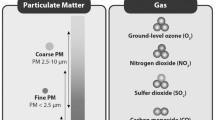Abstract
The objectives of this study were to assess total exposure to radiofrequency electromagnetic fields (RF-EMF) in bedrooms and the contribution of different radioservices (FM radio, analogue TV and DVB-T, TETRA, GSM900 downlink, GSM1800 downlink, UMTS downlink, DECT, and wireless LAN and blue tooth) to the total exposure. Additional aims were to describe the proportion of measuring values above the detection limit of the dosimeters and to characterize the differences in exposure patterns associated with self-reported residential characteristics. Exposure to RF sources in bedrooms was measured using Antennessa® EME Spy 120 dosimeters in 1,348 households in Germany; 280 measures were available for each frequency band per household. Mean electrical field strengths and power flux densities were calculated. Power flux densities allow the calculation of proportions of different radioservices on total exposure. Exposure was often below the detection limit (electrical field strength: 0.05 V/m) of the dosimeter. Total exposure varied, depending on residential characteristics (urban vs. rural areas and floor of a building the measurement took place). Major sources of exposure were cordless phones (DECT standard) and wireless LAN/blue tooth contributing about 82% of total exposure (20.5 μW/m2). Exposure to RF-EMF is ubiquitous, but exposure levels are—if at all measurable—very low and far below the ICNIRP’s exposure reference levels.

Similar content being viewed by others
References
Berg-Beckhoff G, Blettner M, Kowall B, Breckenkamp J, Schlehofer B, Schmiedel S, Bornkessel C, Reis U, Potthoff P, Schüz J (2009) Mobile phone base stations and adverse health effects: phase 2 of a cross-sectional study with measured radio frequency electromagnetic fields. Occup Environ Med 66(2):124–130
Blettner M, Schlehofer B, Breckenkamp J, Kowall B, Schmiedel S, Reis U, Potthoff P, Schüz J, Berg-Beckhoff G (2009) Mobile phone base stations and adverse health effects: phase 1 of a population-based, cross-sectional study in Germany. Occup Environ Med 66(2):118–123
Bornkessel C, Blettner M, Breckenkamp J, Berg-Beckhoff G (2010) Quality control for exposure assessment in epidemiological studies. Radiat Prot Dosimetry 140(3):287–293
Breckenkamp J, Blettner M, Kowall B, Schüz J, Schlehofer B, Schiedel S, Bornkessel C, Reis U, Potthoff P, Berg-Beckhoff G (2010) Ergebnisse einer Querschnittstudie zum Zusammenhang von elektromagnetischen Feldern von Mobilfunksendeanlagen und unspezifischen gesundheitlichen Beschwerden. Umwelt Forsch Prax 15(3):159–166
Helsel D (2005a) More than obvious: better methods for interpreting nondetect data. Environ Sci Technol 39(20):419A–423A
Helsel D (2005b) Nondetects and data analysis. Statistics for censored environmental data. Wiley, Hoboken
ICNIRP International Commission on Non-Ionizing Radiation Protection (1998) Guidelines for limiting exposure to time-varying electric, magnetic and electromagnetic fields (up to 300 GHz). Health Phys 74:494–522
Joseph W, Vermeeren G, Verloock L, Heredia MM, Martens L (2008) Characterization of personal RF electromagnetic field exposure and actual absorption for the general public. Health Phys 95(3):317–330
Knafl U, Lehmann H, Riederer M (2008) Electromagnetic field measurements using personal dosimeters. Bioelectromagnetics 29(2):160–162
LUBW Landesanstalt für Umwelt, Messungen und Naturschutz Baden-Württemberg, LfU Bayerisches Landesamt für Umwelt (ed) (2010) Elektromagnetische Felder im Alltag. Aktuelle Informationen über Quellen, Einsatz und Wirkungen. Self-published, Karlsruhe and Augsburg
Potthoff P, Heinemann LAJ, Güther BA (2004) A household panel as a tool for costs-effective health related population surveys: validity of the „Healthcare Access Panel”. German Med Sci 2:Doc5
Radon K, Spegel H, Meyer N, Klein J, Brix J, Wiedenhofer A, Eder H, Praml G, Schulze A, Ehrenstein V, von Kries R, Nowak D (2006) Personal dosimetry of exposure to mobile telephone base stations? An epidemiologic feasibility study comparing the Maschek dosimeter prototype and the Antennessa DSP-090 system. Bioelectromagnetics 27(1):77–81
Röösli M, Frei P, Mohler E, Braun-Fahrländer C, Bürgi A, Fröhlich J, Neubauer G, Theis G, Egger M (2008) Statistical Analysis of Personal Radiofrequency Electromagnetic Fields With Nondetects. Bioelectromagnetics 29(6):471–478
Röösli M, Frei P, Bolte J, Neubauer G, Cardis E, Feychting M, Gajsek P, Heinrich S, Joseph W, Mann S, Martens L, Mohler E, Parslow RC, Poulsen AH, Radon K, Schüz J, Thuróczy G, Viel JF, Vrijheid M (2010) Conduct of a personal radiofrequency electromagnetic field measurement study proposed study protocol. Environmental Health 9:23
Thomas S, Kühnlein A, Heinrich S, Praml G, Nowak D, von Kries R, Radon K (2008a) Personal exposure to mobile phone frequencies and well-being in adults: a cross-sectional study based on dosimetry. Bioelectromagnetics 29(6):463–470
Thomas S, Kühnlein A, Heinrich S, Praml G, von Kries R, Radon K (2008b) Exposure to mobile telecommunication networks assessed using personal dosimetry and well-being in children and adolescents, the German MobilEe-study. Environ Health 7:54
Thuróczy G, Molnár F, Jánossy G, Nagy N, Kubinyi G, Bakos J, Szabó J (2008) Personal exposimetry in urban area. Ann Telecommun 63(1–2):87–96
Viel JF, Clerc S, Barrera C, Rymzhanova R, Moissonnier M, Hours M, Cardis E (2009) Residential exposure to radiofrequency fields from mobile phone base stations, and broadcast transmitters: a population-based survey with personal meter. Occup Environ Med 66(8):550–556
Funding
The study received its funding entirely from the German Federal Ministry for the Environment, Nature Conversation and Nuclear Safety, within the context of the “Deutsches Mobilfunkforschungsprogramm” (German Mobile Telecommunication Research Programme). The study sponsor had no involvement in study design; in the collection, analysis, and interpretation of data; in the writing of the report; and in the decision to submit the article for publication.
Conflict of interest
None.
Author information
Authors and Affiliations
Corresponding author
Rights and permissions
About this article
Cite this article
Breckenkamp, J., Blettner, M., Schüz, J. et al. Residential characteristics and radiofrequency electromagnetic field exposures from bedroom measurements in Germany. Radiat Environ Biophys 51, 85–92 (2012). https://doi.org/10.1007/s00411-011-0389-2
Received:
Accepted:
Published:
Issue Date:
DOI: https://doi.org/10.1007/s00411-011-0389-2




